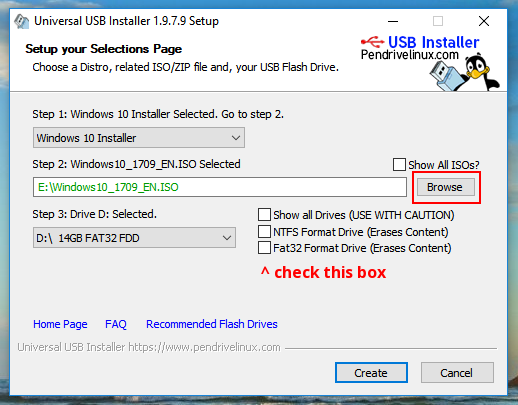

- Create windows 10 bootable usb installer how to#
- Create windows 10 bootable usb installer install#
- Create windows 10 bootable usb installer update#
- Create windows 10 bootable usb installer 32 bit#
USB flash drive ready to use Click Finish Method 3: Manual Creation Now you can use your USB device as bootable media. Downloading Windows 10Īfter the download completed, you are done. It can take few minutes, now you can use your PC for other purposes but don’t shut down your PC! If it is possible, I recommend you to use a faster internet connection to make this step faster. Select your desired USB drive and click Next. If not, you have to free some space from your hard drive and start the process again from step 1. Now the tool will check whether you have enough space on your hard drive or not. Check your PC’s system type before choosing architecture (press the Windows+pause button). Then select your architecture like 32-bit or 64-bit. In N versions, Windows Media Player is not included. You will find many editions like Windows 10 Home, Windows 10 Home N, Windows 10 Pro, Windows 10 Pro N, etc. Choose “Create installation media for another PC” and click the next button. If you are a 64-bit user, download from here.Īfter downloading, click on the downloaded media creation tool and you will see the following image. If you are a 32-bit user, download from here. Before approaching, I recommend you to use an 8GB USB drive(at least 4GB).Īt first, download the media creation tool. So what a windows media creation tool is? This is a tool from Microsoft helps to download windows 10 ISO file directly from windows 10 official Microsoft website. Microsoft has released their own media creation tool that allows creating bootable USB. In USB 3.0, it should be faster, but I don’t know the exact time as I never used a USB 3.0! Method 2: Using Windows 10 Media Creation Tool It will take about 5 minutes if you use a USB 2.0 port and device. Windows 10 bootable USB using RUFUSĬheck ‘Create a bootable disk’ and Click the disc icon, select your downloaded ISO file. I did the same and my bootable drive was successfully created. Leave partition scheme, File System, and Cluster Size unchanged. Open Rufus and choose your desired USB drive that you want to use as bootable media. I prefer an 8GB USB drive for both 32 and 64-bit versions.ĭownload Rufus from their official website HERE. If you want to download the 32-bit version, then you will need a 4GB USB drive and an 8GB USB drive for the 64-bit version. If you cannot figure out which version you should select, then press the Windows +pause button on your PC and you can find it under system type.
Create windows 10 bootable usb installer 32 bit#
You can choose a 32 bit or 64-bit version.
Create windows 10 bootable usb installer install#
One interesting thing is you should not have to install it into your Hard Drive to run it! That means you can use it from an external device or you can stick it on a network location.ĭownload Windows 10 ISO file first. Rufus is a free utility tool that is widely used to create bootable USB. There are some different methods to create a windows 10 bootable USB.
Create windows 10 bootable usb installer how to#
How to create a Windows 10 bootable USB : One more thing is you should use an 8GB USB device or at least a 4GB USB device. So move your data from USB to your PC or somewhere else. After making your USB bootable, you will lose all your previous data stored in your USB.

Things to keep in your mind before approaching:Ī USB device that you will use should be made empty at first. In this article, I will tell you how you can create Windows 10 bootable USB. Creating Windows 10 bootable USB is simple.
Create windows 10 bootable usb installer update#
You can use a USB flash drive to install the latest update of Windows OS, Windows 10. Tired of installing windows updates from DVDs? Then you can try installing from a USB drive.


 0 kommentar(er)
0 kommentar(er)
